7-Day No-Sugar, High-Fiber & High-Protein Meal Plan, Created by a Dietitian
This meal plan will keep you satisfied all day long!
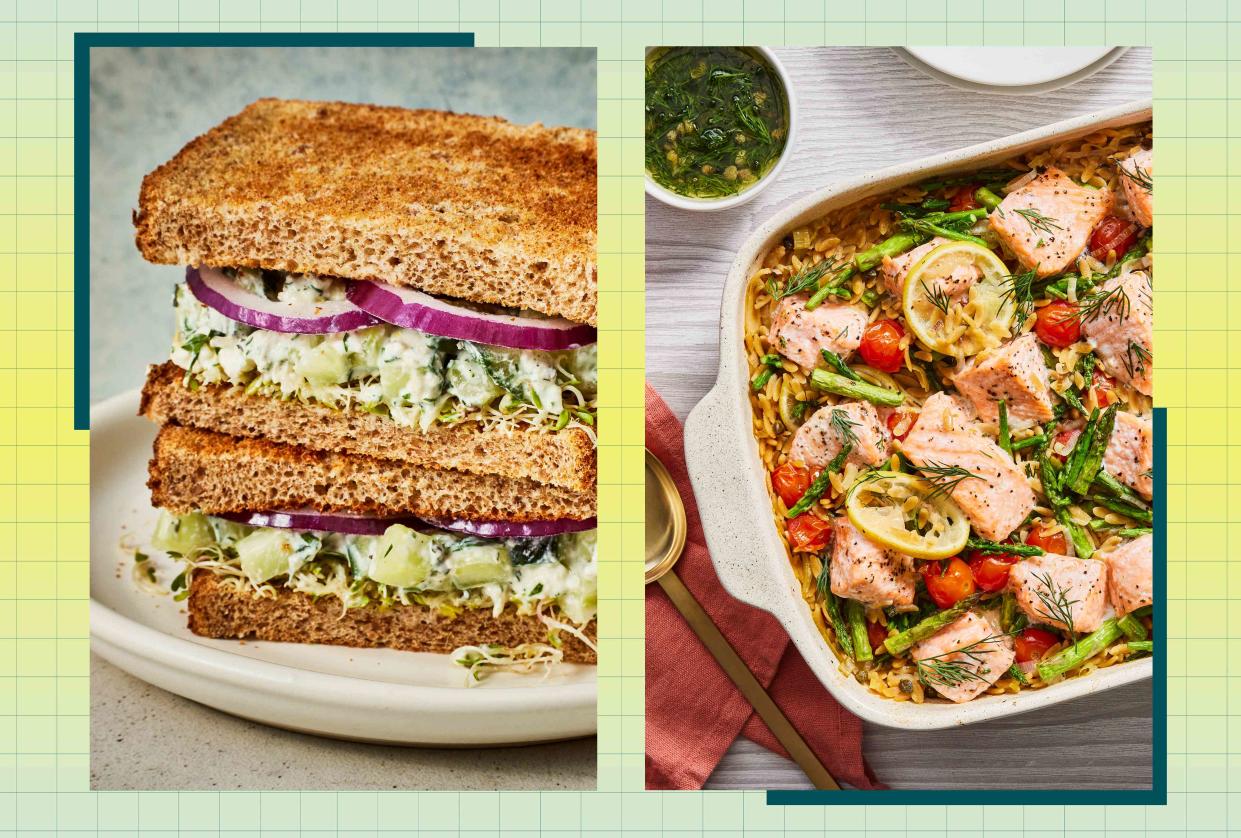
EatingWell
Reviewed by Dietitian Maria Laura Haddad-Garcia
Looking for a meal plan that will keep you feeling satiated? Look no further. In this seven-day meal plan, we map out a week of meals and snacks that focus on two nutrients that play an important role in keeping you full: protein and fiber. Plus, we skip added sugars to leave more room for nutrient-dense foods. To promote a seamless routine, we included some meal-prep tips at the beginning of the week. Let’s check it out!
Why This Meal Plan Is Great for You
These meals provide at least 80 grams of protein and 30 grams of fiber daily to keep you energized between meals. By slowing down your digestion, protein can help you have sustained energy throughout the day.
While desserts and sweet bites can certainly have their place in a healthy eating routine, many people are eating more added sugars than they realize. On average, Americans consume about 17 teaspoons of added sugar each day, significantly over the American Heart Association’s recommended daily max of 9 teaspoons for men and 6 for women. It’s expected that added sugars are in foods like desserts and sweetened beverages, but you may be surprised where else added sugars are making their way into your routine, such as store-bought sauces, dressings and pre-made soups. Take a peek at the nutrition label the next time you’re grocery shopping to see if sugar is listed on the ingredients.
We set this meal plan at 1,500 calories per day and included modifications for 1,200 and 2,000 calories per day, as individual calorie needs vary. To make the job easier for you, we included some meal-prep tips at the beginning of the week for make-ahead breakfast, lunch and snack options. As with all meal plans, use this as a guide, but feel free to make adjustments as needed based on your routine and taste preferences.
Frequently Asked Questions
Is it OK to mix and match meals if there is one I do not like?
Definitely. Swapping a meal to meet your taste preferences is an easy way to make sure you’ll enjoy the meals you eat. In this plan, we aimed for a daily total of 1,500 calories, at least 31 grams of fiber and at least 80 grams of protein—with most days providing more than that. We capped the salt at 2,300 milligrams daily, following the 2020-2025 Dietary Guidelines for Americans. Check out all of our high-protein and high-fiber recipes for more inspiration.
Can I eat the same breakfast or lunch every day?
Yes! Each breakfast option provides 318 to 387 calories, while each lunch has approximately 325 to 425 calories. These calorie ranges are similar enough that swapping one breakfast or lunch option for another should be fairly negligible. If you’re tracking calories closely, adjusting a snack or two to stay within your calorie range may be helpful.
What’s the difference between added and natural sugars?
Natural sugars are found in foods like fruits, vegetables and unsweetened dairy. Added sugars are sweeteners added during processing. Foods containing natural sugars also provide many nutrients, such as vitamins, minerals, protein and fiber, while added sugars only provide sweetness and have little to no nutritional value.
How Do Protein and Fiber Keep You Full?
Protein and fiber both play a role in keeping you full—but how? While both slow down your digestion, each has additional mechanisms. Research shows that when protein is digested, the hunger hormone ghrelin is suppressed while satiety hormones are released, which helps increase feelings of fullness.Fiber is digested slowly, meaning it takes longer to make its way through the digestive system, keeping us fuller for longer. Additionally, soluble fiber is fermented in the colon, forming short-chain fatty acids that increase the release of appetite-regulating peptides, which can also help improve satiety.
Related: Can Eating More Protein Help You Lose Weight? Here's What the Science Says
High-Protein & High-Fiber Foods to Focus On
Beans
Lentils
Dairy
Eggs
Poultry
Fish and shellfish
Meat
Soy
Seitan
Whole grains, such as oats, bulgur, farro, whole wheat and more
Fruit
Vegetables
Nuts and seeds
How to Meal-Prep Your Week of Meals
Make Chicken Fajita Bowls to have for lunch on Days 2 through 5.
Prepare Sun-Dried Tomato & Feta Egg Bites to have for breakfast throughout the week.
Make Quinoa & Chia Oatmeal Mix to have for breakfast throughout the week.
Make Peanut Butter-Oat Energy Balls to have as a snack throughout the week.
Day 1
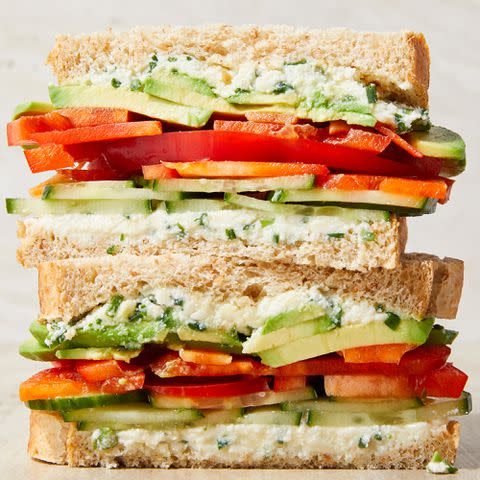
Breakfast (387 calories)
1 serving Sun-Dried Tomato & Feta Egg Bites
1 medium apple
1 cup low-fat plain kefir
A.M. Snack (141 calories)
2 servings Peanut Butter-Oat Energy Balls
Lunch (423 calories)
1 serving Loaded Cucumber & Avocado Sandwich
¼ cup blueberries
P.M. Snack (126 calories)
1 (5.3-oz.) container low-fat plain strained (Greek-style) yogurt
¼ cup raspberries
Dinner (443 calories)
Daily Totals: 1,520 calories, 60g fat, 97g protein, 160g carbohydrate, 32g fiber, 2,019mg sodium
Make it 1,200 calories: Omit kefir at breakfast, change lunch to 1 serving Cucumber Salad Sandwich with 1/4 cup blueberries, and omit yogurt at P.M. snack.
Make it 2,000 calories: Add ¼ cup unsalted dry-roasted almonds to A.M. snack and add 1 medium banana with 1½ Tbsp. natural peanut butter as an evening snack.
Day 2
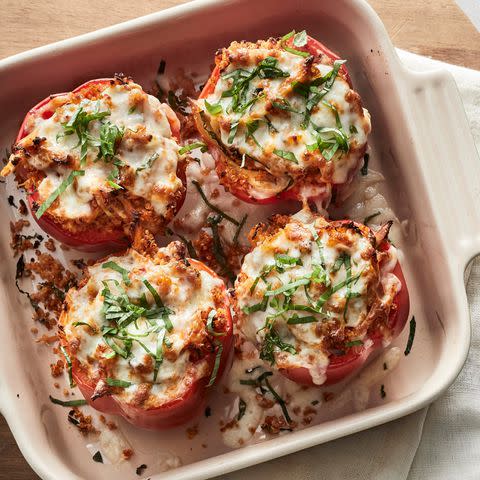
Breakfast (318 calories)
1 serving Quinoa & Chia Oatmeal Mix, prepared with water
2 Tbsp. chopped walnuts
½ cup sliced strawberries
A.M. Snack (141 calories)
2 servings Peanut Butter-Oat Energy Balls
Lunch (360 calories)
1 serving Chicken Fajita Bowls
1 clementine
P.M. Snack (126 calories)
1 (5.3-oz.) container low-fat plain strained (Greek-style) yogurt
¼ cup raspberries
Dinner (566 calories)
Daily Totals: 1,512 calories, 52g fat, 96g protein, 175g carbohydrate, 32g fiber, 1,399mg sodium
Make it 1,200 calories: Omit walnuts at breakfast, change A.M. snack to ½ cup blueberries, and omit yogurt at P.M. snack.
Make it 2,000 calories: Increase to 4 energy balls at A.M. snack, add 3 Tbsp. chopped walnuts to P.M. snack, and add 1 serving Caprese Salad with Cherry Tomatoes to dinner.
Day 3

Photographer: Brie Goldman, Food Stylist: Lauren McAnelly, Prop Stylist: Gabriel Greco
Breakfast (387 calories)
1 serving Sun-Dried Tomato & Feta Egg Bites
1 medium apple
1 cup low-fat plain kefir
A.M. Snack (131 calories)
1 large pear
Lunch (325 calories)
1 serving Chicken Fajita Bowls
P.M. Snack (267 calories)
1 (5.3-oz.) container low-fat plain strained (Greek-style) yogurt
¼ cup raspberries
2 servings Peanut Butter-Oat Energy Balls
Dinner (404 calories)
1 serving Grilled Pork Tenderloin with Cherries
1 serving Roasted Garlic Butter Potatoes
Daily Totals: 1,514 calories, 51g fat, 89g protein, 186g carbohydrate, 31g fiber, 2,080mg sodium
Make it 1,200 calories: Omit apple at breakfast, change A.M. snack to 1 plum, and omit yogurt at P.M. snack.
Make it 2,000 calories: Add ¼ cup unsalted dry-roasted almonds to A.M. snack, increase to 3 servings Peanut Butter-Oat Energy Balls at P.M. snack, and add 1 serving Massaged Kale Salad to dinner.
Day 4

Breakfast (318 calories)
1 serving Quinoa & Chia Oatmeal Mix, prepared with water
2 Tbsp. chopped walnuts
½ cup sliced strawberries
A.M. Snack (212 calories)
3 servings Peanut Butter-Oat Energy Balls
Lunch (325 calories)
1 serving Chicken Fajita Bowls
P.M. Snack (126 calories)
1 (5.3-oz.) container low-fat plain strained (Greek-style) yogurt
¼ cup raspberries
Dinner (520 calories)
Daily Totals: 1,501 calories, 60g fat, 85g protein, 170g carbohydrate, 34g fiber, 1,798mg sodium
Make it 1,200 calories: Omit yogurt at P.M. snack and substitute 1 cup steamed green beans for the couscous at dinner.
Make it 2,000 calories: Increase to ¼ cup chopped walnuts at breakfast, add 1 cup low-fat plain kefir to A.M. snack, add 1 medium apple to lunch, and add ¼ cup unsalted dry-roasted almonds to P.M. snack.
Day 5
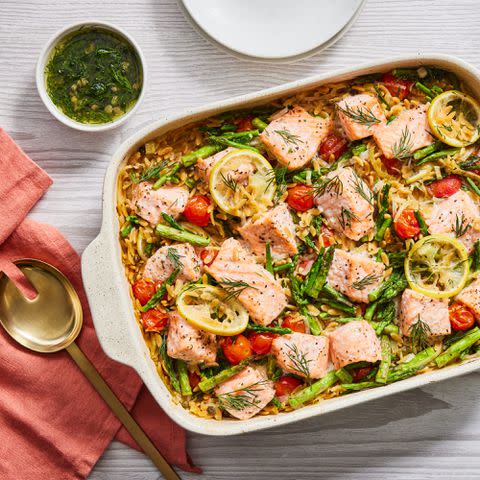
Breakfast (387 calories)
1 serving Sun-Dried Tomato & Feta Egg Bites
1 medium apple
1 cup low-fat plain kefir
A.M. Snack (212 calories)
3 servings Peanut Butter-Oat Energy Balls
Lunch (384 calories)
1 serving Chicken Fajita Bowls
1 medium peach
P.M. Snack (126 calories)
1 (5.3-oz.) container low-fat plain strained (Greek-style) yogurt
¼ cup raspberries
Dinner (391 calories)
Meal-Prep Tip: Reserve two servings Anti-Inflammatory Lemony Salmon & Orzo Casserole to have for lunch on Days 6 and 7.
Daily Totals: 1,499 calories, 53g fat, 90g protein, 176g carbohydrate, 32g fiber, 1,987mg sodium
Make it 1,200 calories: Omit apple at breakfast and change A.M. snack to 1 plum.
Make it 2,000 calories: Add ¼ cup unsalted dry-roasted almonds to A.M. snack, add 2 Tbsp. chopped walnuts to P.M. snack, and add 1 serving Traditional Greek Salad to dinner.
Day 6
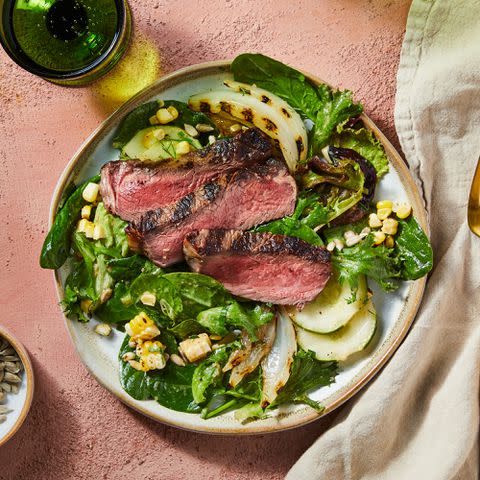
Breakfast (318 calories)
1 serving Quinoa & Chia Oatmeal Mix, prepared with water
2 Tbsp. chopped walnuts
½ cup sliced strawberries
A.M. Snack (140 calories)
½ cup low-fat no-salt-added cottage cheese
1 medium peach
Lunch (391 calories)
P.M. Snack (248 calories)
¼ cup unsalted dry-roasted almonds
½ cup blueberries
Dinner (409 calories)
Daily Totals: 1,506 calories, 76g fat, 84g protein, 133g carbohydrate, 30g fiber, 1,427mg sodium
Make it 1,200 calories: Omit cottage cheese at A.M. snack and omit almonds at P.M. snack.
Make it 2,000 calories: Increase to ¼ cup chopped walnuts at breakfast, add a 1-oz. slice of whole-wheat baguette to dinner, and add 4 servings Peanut Butter-Oat Energy Balls as an evening snack.
Day 7

Breakfast (387 calories)
1 serving Sun-Dried Tomato & Feta Egg Bites
1 medium apple
1 cup low-fat plain kefir
A.M. Snack (131 calories)
1 large pear
Lunch (391 calories)
P.M. Snack (42 calories)
½ cup blueberries
Dinner (555 calories)
1 serving Slow-Cooker Cuban-Style Black Beans
Daily Totals: 1,505 calories, 51g fat, 84g protein, 188g carbohydrate, 32g fiber, 2,276mg sodium
Make it 1,200 calories: Omit kefir at breakfast and omit Slow-Cooker Cuban-Style Black Beans at dinner.
Make it 2,000 calories: Add ¼ cup unsalted dry-roasted almonds to A.M. snack and add ¾ cup low-fat plain strained (Greek-style yogurt) and 2 servings Peanut Butter-Oat Energy Balls to P.M. snack.
Read the original article on Eating Well.











